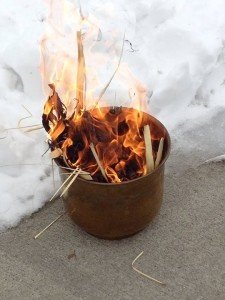
Palms Burning in Point Edward, ON. Photo taken by the Rev. Kristen Oliver, and used with her permission.
After sharing Jennifer Phillips’ prayer for the burning of the palms last year, I had a conversation with a colleague. The Rev. Canon Joseph Asselin—rector of St. Cuthbert’s in Oakville—and I talked about how for some years, he’s gathered people near the end of the pancake supper to go out to burn the palms into the ashes for the next day. In part, it’s a way of connecting the well-attended communal liturgy of the pancakes with the less-frequented imposition of ashes.
This year, instead of burning the palms with youth during a release day from school, or under the supervision of the Tuesday Men at the parish in which I serve, we burned them after church on Sunday. As most folk gathered with coffee and a biscuit, they peered out the windows at me and the others who together braved the cold and the malodorous smoke. We poured some of the remnants into an old baking pan, brought it inside, and set it on a trivet. I invited everyone to take a turn helping to stir them with the pestle, and went outside to burn more palms (our largest parish fundraiser is supplying palms to other church communities—we had a lot!).
When I came back in with the next batch, I enjoyed standing back and listening. One man murmured “ashes to ashes” to himself as he stirred. Another parishioner became dismayed at how the ashes she’d gotten on her hands simply didn’t want to come off. Some marvelled at the smallness of the ash compared to the large pile of palms. One asked if we would mix in oil on Wednesday.
More than anything else, what struck me was the way they connected with this act that is often overlooked by those who’ll have a cross marked on their foreheads this year and be reminded that they are dust, and to dust they will return. They were helping to make these ashes from the palms they’d brought in, brought back to the church. The palms that they’d seen blessed, that they’d been given last year. The palms that many of them had helped to fold into crosses. They were seeing a part of the cycle that had been un-noticed before, and were drawn more deeply into the reminder of mortality because of it.
It will be interesting to pay attention, and to listen for how it struck people in other ways. Perhaps this is another opportunity to help draw connections between the reminder of our mortality and the staggering truth of how Jesus shares it with us. That precisely in this constraint of the end of our mortal lives that is woe and sorrow is freedom and joy, because of the gift of the paschal mystery.
In his comments last year, Joe asked if some communities offer ashes on Sunday, too, for those who won’t be able to make it out on Ash Wednesday. He asks a good question about how we help to make symbols speak. It’s one that others are wrestling with, perhaps most noted in the reporting and discussion that emerge from efforts like “Ashes on the Go.”
[If you’re interested in hearing some different perspectives on Ashes on the Go, take a look at: some general background here, and the Reverend Canon Gordon Reid’s hopeful musings here, and the Reverend Michael Sniffen’s concerns about the practice here.]
How does the symbol of the ashes speak to you? And how might we help to let the good news we proclaim as this season of preparation begins speak more loudly and clearly in the lives of the wider communities we serve? What happens in your context?

By Akinlehin Akinbobola March 5, 2014 - 1:05 pm
Restitution….. Gloria in excel sis Deo !
By Laura Marie Piotrowicz March 5, 2014 - 12:14 pm
I’ve had a number of conversations this week from people asking “why?” about many of our traditions. In my experience, there are a number of folks who simply don’t understand the traditions we take part in (why we have pancakes on Shrove Tuesday, why the church is “colour-coded”, etc.) I find myself trying to mix a bit of education in whenever possible, but am aware of a limitation of knowledge on the church’s rich traditions.
Great idea to involve the regular Sunday community in the Tuesday burning tradition. I may borrow that next year 🙂